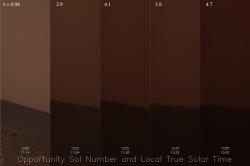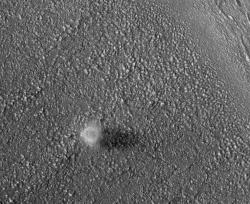Mars recently experienced a dust storm covering almost the entire planet. The two robotic vehicles, Spirit and Opportunity, will learn first-hand the effect of these storms on their functioning. * And a dust elf from Adimai was photographed from above by MRO

Mars recently experienced a dust storm covering almost the entire planet. The two robotic vehicles, Spirit and Opportunity, will learn first-hand the effect of these storms on their functioning.
The dust now blocks 99% of direct sunlight. Since their electrical generation capacity is poor, the vehicles will not be able to generate enough electricity to run their heaters. It is these heaters that keep the core of the electronic components from getting too cold in the freezing weather of the Martian soil.
Before the dust storm, Opportunity's generator produced about 800 watts per day. During the Habak storm, the electricity output dropped to 400 watts. The managers of the operation had to save on the hours of vehicle activity, including driving, use of the robotic arm, cameras and scientific instruments. On Wednesday, July 18, the electricity output dropped to 128 watts.
If the strong storm continues for a long time, at least one if not both of the vehicles may experience permanent damage or even be disabled. Such storms can last for days but often weeks or more.
And more about the Martian storms

An interesting picture of a sand hurricane, a phenomenon known as the "Martian dust devil" was taken by the HiRISE camera installed on the MRO (Mars Reconnaissance Orbiter). This sand devil has nothing to do with the storm that occurs in most of the planet's area. The picture was taken about a month ago in the hemisphere The southern near the Las plain, in the afternoons in this area.
Such sandstorms form when temperatures on the surface of Mars are warmer than in the air above the ground. The warm air rises and if the conditions are right starts to swirl into a vortex that draws in more warm air. If the stirrer gets strong enough, it sucks dust from the ground and thus a sand elf is created.
From the spacecraft's point of view, the sand elf is 200 meters in diameter, but near the ground it is probably much smaller in diameter. From the ground it looks like a dust tornado rising 500 meters high.
